Disclosure: Meeple Mountain received a free copy of this product in exchange for an honest, unbiased review. This review is not intended to be an endorsement.
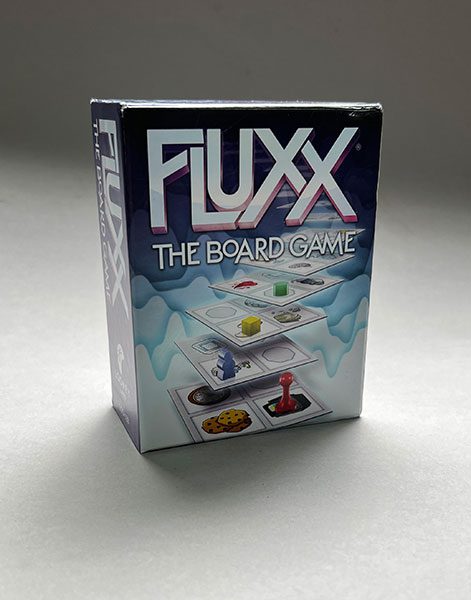
I have played, enjoyed, and reviewed five different versions of the Looney Labs’ card game Fluxx. Those games each start with barely enough rules to start the game—rules that grow, shrink, change, and, well, remain in flux(x) for the duration of the game.
Back in 2013, Looney Labs released a board game version of Fluxx called, appropriately enough, Fluxx: The Board Game. Recently, the good people at Looney Labs asked me if I was interested in reviewing the new, compact edition of the game.
They didn’t need to ask twice.
The Game
Fluxx: The Board Game, like its card game predecessor, is a game about getting Goal cards. You read that right: Goal cards. Goal cards are collected by getting your markers on the correct pairs of icon spaces on the board. Be the first player to collect a predetermined number of Goal cards and you’ll win the game.
Confused? Intrigued? Read on and all will become clear.
The Cards
In my reviews of the Fluxx card games, I’ve always written about the different types of cards that make up the game. In each iteration of the card game, the cards will provide the biggest changes. With Fluxx: The Board Game, the cards are a good starting point because they’ll demonstrate the familiar and the very different.
For instance, take the Goal cards. If you’ve ever played the original version of Fluxx, you’ll recognize the art and the items that make up the Goals. Goals still represent the conditions you need to meet to win the game.
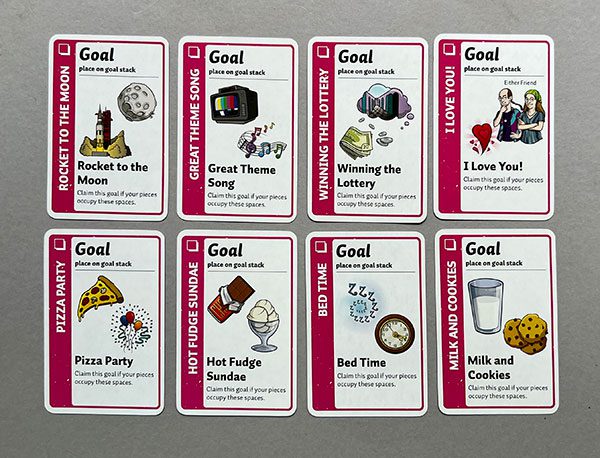
The Partially Similar, The Partially Different
And take a look at these Action cards. The top row of these single-use cards in the photograph, below, should look familiar. The bottom row cards, however, are definitely new.
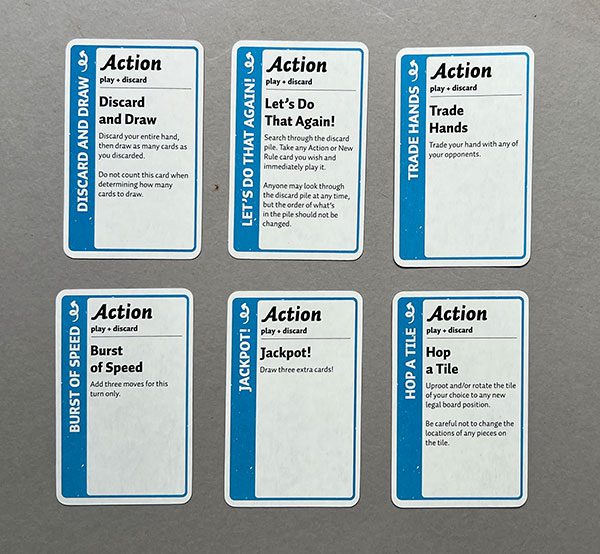
At the heart of every Fluxx card game are the New Rule cards. Played throughout the game, they change all sorts of things—for instance, the number of cards you can draw, play, and hold in your hand.
Here, New Rule cards can still alter the cards in your hand. Most of them, however, have to do with that board part of Fluxx: The Board Game.
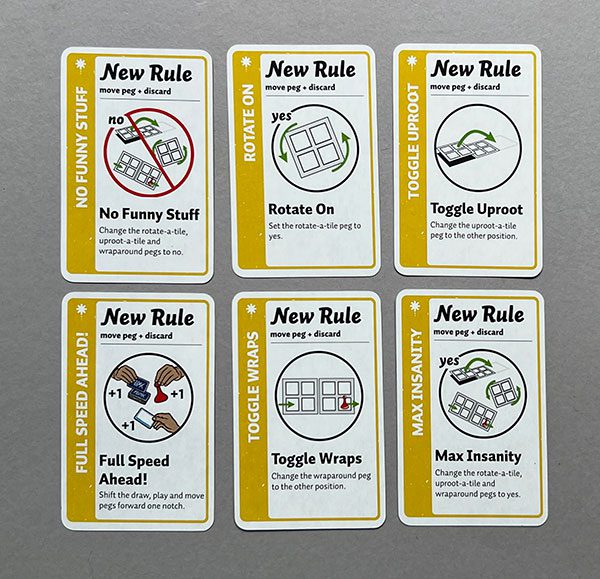
Before getting to that board, we need to look at a few other new components to the game.

You’ll start each game by taking five Goal cards from the deck and placing them onto the “Place Goals Here” space. Then place a peg in the number to the right that corresponds with the agreed upon number of Goals required to win the game. Throughout the game, you’ll add to this pile by playing other Goal cards from your hand to the top of this growing deck of Goals.
Those odd New Rule cards will change the Fluxxuator® settings. The game starts with a peg being placed to the far left of each area to indicate the standard Draw One, Play One—and Two Movement actions and an unlimited hand limit. As well, all the options for moving parts of the board around are initially set to No.
However, to get the fun started, each player gets to make one change to the Fluxxuator® before the game starts.
“But, wait,” I can hear you ask. “What about the Keeper cards?”
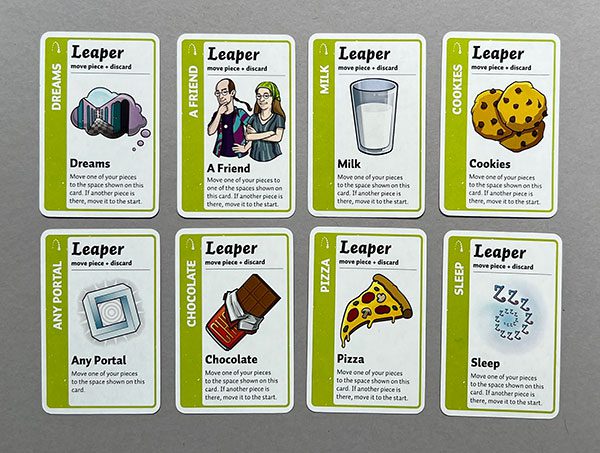
Since winning Fluxx: The Board Game involves collecting several Goals, including the Keeper cards from the card game versions of Fluxx doesn’t quite work here. However, being able to instantly travel across the board to a specific location could be helpful. Therefore, Keepers have been replaced by Leapers.
Speaking of the board, let’s take a look at an example of a possible layout.

The board is made up of a Fluxx starting square that always forms the starting center square of the board. You’ll start the game with all three of your pieces on this tile and they may only enter the board through the spaces indicated by the four purple arrows.
The rest of the board is made up of eight squares, each with four icons. Each square will have icons that match the Goal cards, and a hexagon. Only one person’s token can be on a Goal icon at a time. If you move onto an occupied icon, you push that token onto any vacant icon ahead or to the side of that space.
There are two special icons that represent Portals. If you land on one of these icons, your token is transported immediately to the other Portal. This can be a good way of getting to where you want to go faster than the current movement actions allow.
Playing the Game
Let’s put that all together to play the game, shall we?
To begin: setup the board, layout the starting goals, and set up the player pieces according to their chosen color. (This being a Fluxx game, of course you might change your color during the game.)

Deal each player three cards and then have each player make a single change to the Fluxxuator board.
To quote the rules:
Whoever says, “I’m going first!” first, goes first!
On a turn, you will:
- Draw the number of cards indicated on the Fluxxuator®
- Move a piece—or split the movement actions between pieces—the number of times indicated on the Fluxxuator®
- Play the number of cards shown on the Fluxxuator®
- Discard down to the Hand Limit (if necessary)
When you have two of your pieces on the icons associated with the topmost Goal, you place it in front of you. The Goals you accumulate stay with you throughout the game, even if the color of pieces you’re playing changes.
The first player to reach the agreed upon number of Goals wins the game.
Thoughts
If you’re a fan of the Fluxx card games and don’t already own a copy of Fluxx: The Board Game, I hope I’ve convinced you to give it a try. The changes made to incorporate a board into Fluxx works well. If anything, Fluxx: The Board Game has more Fluxxable options than the card games do.
And, if you’re wondering how this version will fit with your stack of Fluxx card games, the compact edition is the same size as two Fluxx card games stacked one atop the other.
I did notice a few things during our plays, however. The game can be very short—too short, really. The rules suggest your first game be played to three Goals. That game only lasted five minutes, so we doubled the number of Goals needed to win and had a much more enjoyable time.
We all agreed that, after two or three plays, the board started to feel too small. There are 32 icons on the board, and unless you’re able to Uproot a tile (literally, move one of the tiles of the board to another place with a full side-to-side connection) on a turn, getting your pieces to the necessary Goal icons isn’t that difficult. (Hint: set the Uproot peg to Yes as your starting change.)
I also wish there were either more tiles or that each tile had more than four icons. Rectangular tiles with more, smaller icons would have been welcomed.
That aside, Fluxx: The Board Game is a fun filler that plays in around ten minutes. I’ve added it to my list of gateway games for people I suspect would like a game that mixes the familiar (moving tokens around a board) with the very different (the Fluxxuator®). I suspect it might get more time at the table than any of my Fluxx card games.





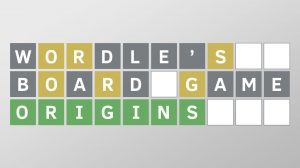






Add Comment